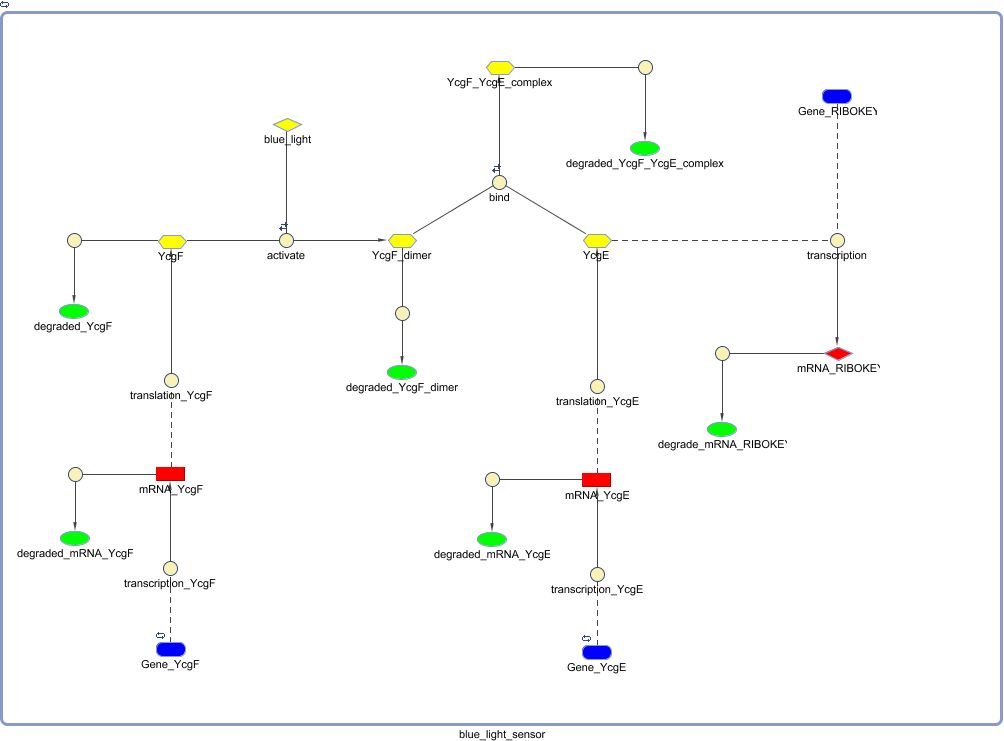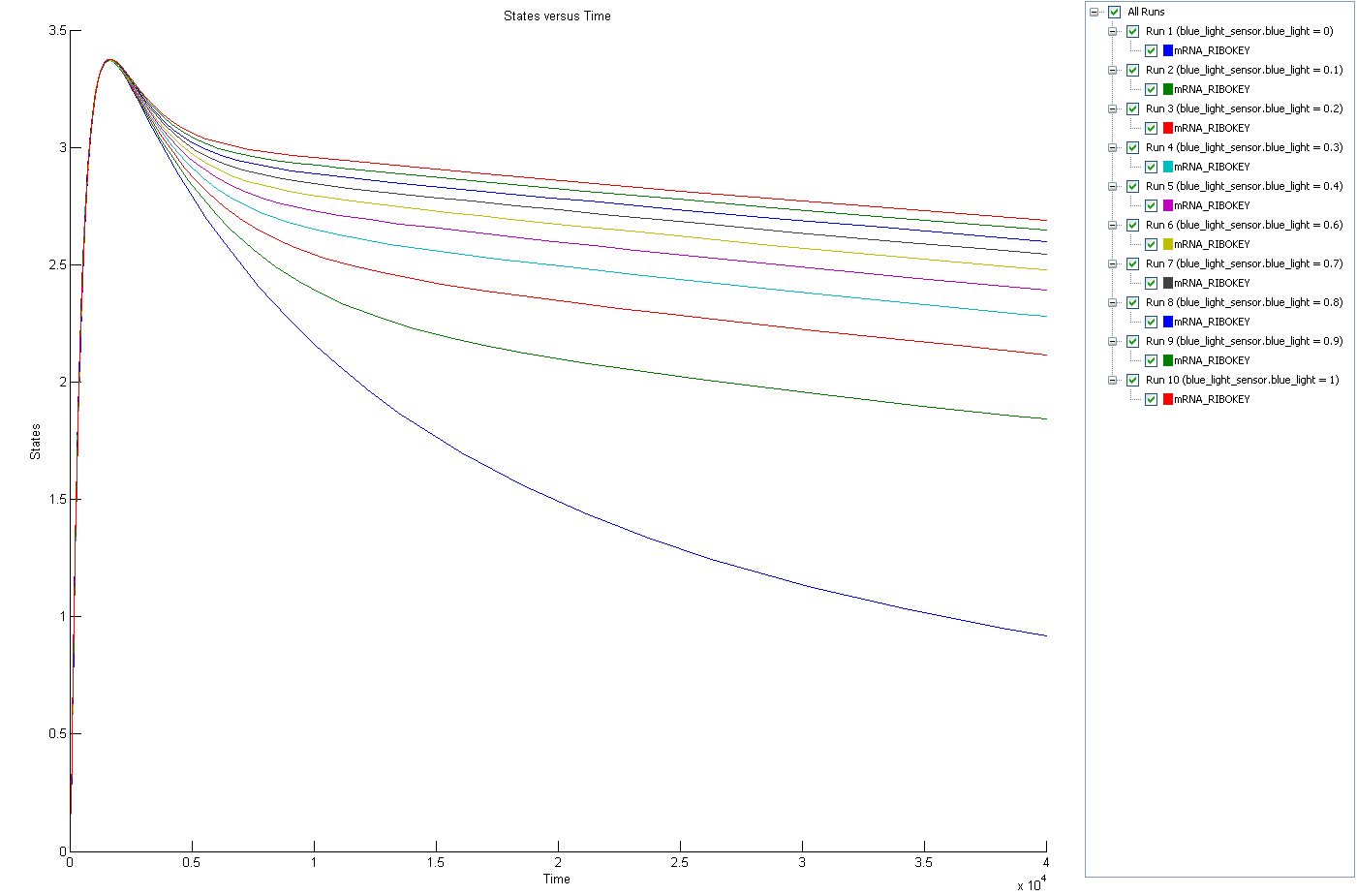Team:KULeuven/Modeling/Blue Light Receptor
From 2009.igem.org
(Difference between revisions)
(→Mathematical Model) |
(→Mathematical Model) |
||
| Line 40: | Line 40: | ||
! colspan="4" style="border-bottom: 1px solid #003E81;" | Transcription Rates | ! colspan="4" style="border-bottom: 1px solid #003E81;" | Transcription Rates | ||
|- | |- | ||
| - | | k<sub>transcription</sub> | + | | k<sub>transcription YcgF</sub> |
| + | | 0.0154 s<sup>-1</sup> | ||
| + | | Rate is faster than transcription rate of YcgE | ||
| + | | [https://2009.igem.org/Team:KULeuven/Modelling/Vanillin_Production#References [1<html>]</html>] | ||
| + | |- | ||
| + | | k<sub>transcription YcgE</sub> | ||
| 0.00848 s<sup>-1</sup> | | 0.00848 s<sup>-1</sup> | ||
| estimate | | estimate | ||
| - | | [https://2009.igem.org/Team:KULeuven/Modelling/Vanillin_Production#References [ | + | | [https://2009.igem.org/Team:KULeuven/Modelling/Vanillin_Production#References [1<html>]</html>] |
|- | |- | ||
| - | | k<sub> | + | ! colspan="4" style="border-bottom: 1px solid #003E81;" | Dimerization Parameters |
| - | | 0. | + | |- |
| - | | | + | | k<sub>dimerization</sub> |
| - | | [https://2009.igem.org/Team:KULeuven/Modelling/Vanillin_Production#References [ | + | | 8.0E-11 (s molecule)<sup>-1</sup> |
| + | | Rate of dimerization of YcgF [molecule = 1 W/m�^2] | ||
| + | | [https://2009.igem.org/Team:KULeuven/Modelling/Vanillin_Production#References [2<html>]</html>] | ||
| + | |- | ||
| + | | k<sub>dissociation</sub> | ||
| + | | 0.0058 s<sup>-1</sup> | ||
| + | | Rate of dissociation of the YcgF complex | ||
| + | | [https://2009.igem.org/Team:KULeuven/Modelling/Vanillin_Production#References [3<html>]</html>] | ||
|- | |- | ||
| - | ! colspan="4" style="border-bottom: 1px solid #003E81;" | | + | ! colspan="4" style="border-bottom: 1px solid #003E81;" | YcgF/YcgE Interaction |
|- | |- | ||
| - | | k<sub> | + | | k<sub>bind</sub> |
| - | | | + | | 100 (s molecule)<sup>-1</sup> |
| - | | Rate of | + | | Rate of binding of YcgF dimer to YcgE |
| [https://2009.igem.org/Team:KULeuven/Modelling/Vanillin_Production#References [2<html>]</html>] | | [https://2009.igem.org/Team:KULeuven/Modelling/Vanillin_Production#References [2<html>]</html>] | ||
|- | |- | ||
| - | | k<sub> | + | | k<sub>unbind</sub> |
| - | | | + | | 1 s<sup>-1</sup> |
| - | | Rate of | + | | Rate of dissociation of the YcgF/YcgE complex |
| [https://2009.igem.org/Team:KULeuven/Modelling/Vanillin_Production#References [3<html>]</html>] | | [https://2009.igem.org/Team:KULeuven/Modelling/Vanillin_Production#References [3<html>]</html>] | ||
|- | |- | ||
Revision as of 08:29, 18 September 2009
Contents |
Blue light Sensor
Biological Model
Mathematical Model
| Name | Value | Comments | Reference |
|---|---|---|---|
| Degradation Rates | |||
| dmRNA | 2.3105E-3 s-1 | [4] | |
| dProteins | 1.9254E-5 s-1 | [5] | |
| Transcription Rates | |||
| ktranscription YcgF | 0.0154 s-1 | Rate is faster than transcription rate of YcgE | [1] |
| ktranscription YcgE | 0.00848 s-1 | estimate | [1] |
| Dimerization Parameters | |||
| kdimerization | 8.0E-11 (s molecule)-1 | Rate of dimerization of YcgF [molecule = 1 W/m�^2] | [2] |
| kdissociation | 0.0058 s-1 | Rate of dissociation of the YcgF complex | [3] |
| YcgF/YcgE Interaction | |||
| kbind | 100 (s molecule)-1 | Rate of binding of YcgF dimer to YcgE | [2] |
| kunbind | 1 s-1 | Rate of dissociation of the YcgF/YcgE complex | [3] |
Simulation
The amount of produced RIBOKEY is positively correlated on the incident blue radiation. The build up of key in the begin period of is due to the relative slow build up of the active state of YcgF protein in compared to the build up of YcgE.
References
[1] Natalia Tschowri, Susan Busse and Regine Hengge, "The BLUF-EAL protein YcgF acts as a direct anti-repressor in a blue-light response of Escherichia coli"
[2] Y. Nakasone et al., "Transient Dimerization and Conformational Change of a BLUF Protein: YcgF", Journal of the American Chemical Society, Apr. 2006
 "
"










